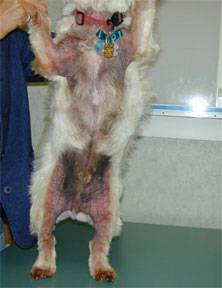AtopicDermWB_DrCarolFoil

This White West Highland terrier has a classic case of atopic dermatitis. Photo courtesy of Dr. Carol Foil
Atopic dermatitis in dogs (allergic dermatitis, canine atopy) is a hypersensitivity or overreaction to a variety of commonplace and otherwise harmless substances in the environment. These allergens include plant pollens, house dust mites, or mold spores. Most allergic dogs begin to show signs between one and three years of age. Several dog breeds seem predisposed to allergies. These dog breeds include Golden Retrievers, Labrador Retrievers, West Highland White Terriers and other terriers, and Bulldogs. However, any dog, including mixed-breed dogs, can have atopic dermatitis.
Signs
Atopic dogs will scratch, chew, lick, or rub areas of the body such as the paws, face, and rear end. This itchy behavior, or pruritus, can cause hair loss and reddening and thickening of the skin. Parasites, such as fleas and bacterial or yeast infections, can then further increase the itch level of allergic dogs. Atopic dogs can also have ear and anal gland problems.
Diagnosis
Once your pet’s veterinarian has diagnosed the cause of your dog’s itching, allergy tests can be used to identify what your dog is allergic to in the environment. There are two types of allergy tests: the intradermal allergy test and blood testing for allergies (serologic allergy testing). In an intradermal allergy test, the fur is clipped on one side of the chest, and small amounts of common allergens are injected into the skin. The skin is then observed for a reaction to the allergen. In a blood allergy test, a blood sample is obtained and sent to a laboratory. At the laboratory, the protein levels (antibodies) to the allergens are measured.
Each allergy test has its advantages and disadvantages. Most veterinary dermatologists recommend intradermal allergy testing. This is because many factors, including which laboratory is performing the test, can affect the results of blood allergy testing. However, intradermal allergy testing has the disadvantage of needing to be done by a specialist and usually requires a mild sedative to relax the dog during the test.
Treatment
If your dog is diagnosed with atopic dermatitis, there are three methods of therapy.
- Avoiding allergens: It is usually not possible to remove all allergens from a pet's environment because even a small amount can trigger a dog’s allergies. However, bathing can help remove allergens from the skin. A hypoallergenic cream rinse or spray can re-moisturize the skin after bathing.
- Medications: A variety of anti-allergy drugs are available. These drugs include antihistamines, steroids (cortisone), cyclosporine, oclacitinib, ilunocitinib, and lokivetmab. Some dogs develop side effects from taking certain anti-itch medications, such as steroids. Different anti-allergy medications may need to be tried because not every medication works for all pets.
- Allergen-specific immunotherapy: Immunotherapy involves giving a series of diluted allergens based on what your dog is allergic to. Allergen-specific immunotherapy makes dogs less sensitive to their allergens, and 60-80% of patients improve on immunotherapy. However, improvement in immunotherapy takes time, and it is important to try the immunotherapy for several months before it can take effect. When helpful, immunotherapy is usually continued lifelong but can be given less frequently over time.